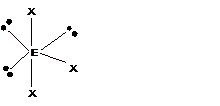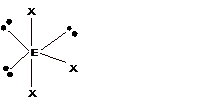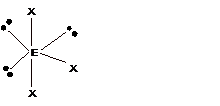
GENERAL CHEMISTRY-MOD.MASTERINGCHEM.
11th Edition
ISBN: 9780134193601
Author: Petrucci
Publisher: PEARSON
expand_more
expand_more
format_list_bulleted
Question
Chapter 22, Problem 7E
Interpretation Introduction
(a)
Interpretation:
The probable geometric structure of
Concept introduction:
- Valence shell electron pair repulsion theory (VSEPR) predicts the geometry of the molecules depending on the number of bond pair of electrons and number of lone pair of electrons.
- Electron pair geometry includes both bonded atoms and lone pairs, while molecular geometry only considers the bonded atoms.
- The geometries corresponding to different steric number is shown − Steric number = number of bond pairs +number of lone pairs
| VSEPR GEOMETRIES | |||||
| Steric number | 0 lone pairs | 1 lone pair | 2 lone pairs | 3 lone pairs | 4 lone pairs |
| 2 |  Linear |
||||
| 3 | Trigonal planar |
Bent |
|||
| 4 | Tetrahedral |
Trigonal pyramidal |
Bent |
||
| 5 | TrigonalBipyramidal |
Seesaw |
T-shape |
Linear |
|
| 6 | Octahedral |
Square pyramidal |
Square planar |
T-shape |
Linear |
Interpretation Introduction
(b)
Interpretation:
The probable geometric structure of
Concept introduction:
- Valence shell electron pair repulsion theory (VSEPR) predicts the geometry of the molecules depending on the number of bond pair of electrons and number of lone pair of electrons.
- Electron pair geometry includes both bonded atoms and lone pairs, while molecular geometry only considers the bonded atoms.
- The geometries corresponding to different steric number is shown − Steric number = number of bond pairs +number of lone pairs
| VSEPR GEOMETRIES | |||||
| Steric number | 0 lone pairs | 1 lone pair | 2 lone pairs | 3 lone pairs | 4 lone pairs |
| 2 |  Linear |
||||
| 3 | Trigonal planar |
Bent |
|||
| 4 | Tetrahedral |
Trigonal pyramidal |
Bent |
||
| 5 | TrigonalBipyramidal |
Seesaw |
T-shape |
Linear |
|
| 6 | Octahedral |
Square pyramidal |
Square planar |
T-shape |
Linear |
Interpretation Introduction
(c)
Interpretation:
The probable geometric structure of
Concept introduction:
- Valence shell electron pair repulsion theory (VSEPR) predicts the geometry of the molecules depending on the number of bond pair of electrons and number of lone pair of electrons.
- Electron pair geometry includes both bonded atoms and lone pairs, while molecular geometry only considers the bonded atoms.
- The geometries corresponding to different steric number is shown − Steric number = number of bond pairs +number of lone pairs
| VSEPR GEOMETRIES | |||||
| Steric number | 0 lone pairs | 1 lone pair | 2 lone pairs | 3 lone pairs | 4 lone pairs |
| 2 |  Linear |
||||
| 3 | Trigonal planar |
Bent |
|||
| 4 | Tetrahedral |
Trigonal pyramidal |
Bent |
||
| 5 | Trigonal Bipyramidal |
Seesaw |
T-shape |
Linear |
|
| 6 | Octahedral |
Square pyramidal |
Square planar |
T-shape |
Linear |
Expert Solution & Answer
Want to see the full answer?
Check out a sample textbook solution
Students have asked these similar questions
20.17 Predict the structure of the major product formed by 1,2-addition of HBr to
3-methylenecyclohexene.
3-Methylenecyclohexene
20.18 Predict the major product formed by 1,4-addition of HBr to 3-methylenecyclohexene.
+
Draw a vicinal alkyl bromide that would produce the following alkene in an E2
elimination. Use a dash or wedge bond to indicate stereochemistry on
asymmetric centers, where applicable. Ignore any inorganic byproducts.
Br
Drawing
Strong Base
H
Q
Atoms, Bonds
Charges
and Rings
Draw or tap a new bond to see suggestions.
Remove
Done
語
Reset
Undo
+
Drag To Pan
Draw a vicinal alkyl bromide that would produce the following alkene in an
E2 elimination. Use a dash or wedge bond to indicate stereochemistry on
asymmetric centers, where applicable. Ignore any inorganic byproducts.
+
Drawing
Į
Strong Base
H
Br
Q
Atoms, Bonds
and Rings
Charges
Draw or tap a new bond to see suggestions.
Undo
Reset
謂
Remove
Done
Drag To Pan
+
Chapter 22 Solutions
GENERAL CHEMISTRY-MOD.MASTERINGCHEM.
Ch. 22 - Give the formula of the stable fluride by Li, Be,...Ch. 22 - Fluorine is able to stabilize element’s in very...Ch. 22 - Prob. 3ECh. 22 - Prob. 4ECh. 22 - Prob. 5ECh. 22 - Prob. 6ECh. 22 - Prob. 7ECh. 22 - Use VSEPR theory to predict the probable geometric...Ch. 22 - Prob. 9ECh. 22 - Prob. 10E
Ch. 22 - Prob. 11ECh. 22 - Prob. 12ECh. 22 - Prob. 13ECh. 22 - Prob. 14ECh. 22 - Make a general prediction about which of the...Ch. 22 - The following properties of astatine have been...Ch. 22 - Prob. 17ECh. 22 - Prob. 18ECh. 22 - Prob. 19ECh. 22 - Prob. 20ECh. 22 - Prob. 21ECh. 22 - Prob. 22ECh. 22 - Prob. 23ECh. 22 - Prob. 24ECh. 22 - Each of the following compounds decomposes to...Ch. 22 - Ozone is a power oxidizing agent. Using ozone as...Ch. 22 - Prob. 27ECh. 22 - Prob. 28ECh. 22 - Prob. 29ECh. 22 - Prob. 30ECh. 22 - Prob. 31ECh. 22 - Prob. 32ECh. 22 - Prob. 33ECh. 22 - In water, O2(aq) is a strong base. If 100.0 mg of...Ch. 22 - The conversion of O2(g) to O2(g) can be...Ch. 22 - Prob. 36ECh. 22 - Prob. 37ECh. 22 - Prob. 38ECh. 22 - Prob. 39ECh. 22 - Prob. 40ECh. 22 - Prob. 41ECh. 22 - Joseph Priestley, e British chemist, was credited...Ch. 22 - Give an appropriate name to each of theb following...Ch. 22 - Prob. 44ECh. 22 - Give a specific example of a chemical equation...Ch. 22 - Prob. 46ECh. 22 - Prob. 47ECh. 22 - Prob. 48ECh. 22 - Prob. 49ECh. 22 - Prob. 50ECh. 22 - Prob. 51ECh. 22 - Prob. 52ECh. 22 - Prob. 53ECh. 22 - Prob. 54ECh. 22 - Prob. 55ECh. 22 - Prob. 56ECh. 22 - Prob. 57ECh. 22 - Prob. 58ECh. 22 - Prob. 59ECh. 22 - One reaction that competes with reaction (22.41),...Ch. 22 - Prob. 61ECh. 22 - Prob. 62ECh. 22 - Draw plausible Lewis structures for a....Ch. 22 - Both nitramide and hyponitrous acid have the...Ch. 22 - Prob. 65ECh. 22 - Prob. 66ECh. 22 - Prob. 67ECh. 22 - Prob. 68ECh. 22 - Prob. 69ECh. 22 - Prob. 70ECh. 22 - Use data from Table 7.2 (page 273) to calculate...Ch. 22 - Prob. 72ECh. 22 - Prob. 73ECh. 22 - Prob. 74ECh. 22 - Prob. 75ECh. 22 - What volume of H2(g) at 25C and 752 mmHg is...Ch. 22 - Prob. 77ECh. 22 - How many grams of CaH2(s) are required to generate...Ch. 22 - Prob. 79ECh. 22 - On the basis of molecular orbital theory, would...Ch. 22 - Prob. 81IAECh. 22 - Prob. 82IAECh. 22 - Prob. 83IAECh. 22 - The photograph was taken after a few drops of a...Ch. 22 - Prob. 85IAECh. 22 - Prob. 86IAECh. 22 - Prob. 87IAECh. 22 - Despite the fact that it has the higher molecular...Ch. 22 - The text mentions that ammonium perchlorate is an...Ch. 22 - Prob. 90IAECh. 22 - Prob. 91IAECh. 22 - Prob. 92IAECh. 22 - Refer to Figure 11-25 to arrange the following...Ch. 22 - Prob. 94IAECh. 22 - Prob. 95IAECh. 22 - Estimate the percent dissociation of CI2(g) into...Ch. 22 - Prob. 97IAECh. 22 - The structure of N(SiH2)2 involves a planar...Ch. 22 - Prob. 99IAECh. 22 - Refer to the Integrative Example on page 1082....Ch. 22 - The bond energies of CIz and 159kJmol1 are 243 and...Ch. 22 - Prob. 102IAECh. 22 - Prob. 103IAECh. 22 - Prob. 104IAECh. 22 - Prob. 105IAECh. 22 - The heavier halogens (CI, Br, and I) form...Ch. 22 - Prob. 107IAECh. 22 - Chemists have successfully synthesized the ionic...Ch. 22 - Prob. 109IAECh. 22 - Various thermochemical cycles are being explored...Ch. 22 - The decomposition of aqueous hydrogen peroxide is...Ch. 22 - Both in this chapter and in Chapter 19, we have...Ch. 22 - Prob. 113FPCh. 22 - The so-called pyroanions, X2O7n+ , form a series...Ch. 22 - A description of bonding in XeF2 based on the...Ch. 22 - Prob. 116FPCh. 22 - Prob. 117SAECh. 22 - Prob. 118SAECh. 22 - Prob. 119SAECh. 22 - Which of the following can oxidize Br to Br2 in...Ch. 22 - Prob. 121SAECh. 22 - Prob. 122SAECh. 22 - Prob. 123SAECh. 22 - Prob. 124SAECh. 22 - Prob. 125SAECh. 22 - Prob. 126SAECh. 22 - Prob. 127SAECh. 22 - Give a practical laboratory method that you might...Ch. 22 - Prob. 129SAECh. 22 - Prob. 130SAECh. 22 - Prob. 131SAECh. 22 - Prob. 132SAECh. 22 - Prob. 133SAECh. 22 - Prob. 134SAECh. 22 - Prob. 135SAE
Knowledge Booster
Similar questions
- Draw the product of the E2 reaction shown below. Include the correct stereochemistry. Ignore any inorganic byproducts. + Br CH3 Q Strong Base Drawing Atoms, Bonds and Rings Charges Undo Reset H "Br H N Br. Remove Done .N. Drag To Panarrow_forwardCurved arrows are used to illustrate the flow of electrons. Use the reaction conditions provided and follow the curved arrows to draw the product of this elementary step in an elimination mechanism. Include all lone pairs and charges as appropriate. Ignore stereochemistry. Ignore byproducts. + Br: .. 8 0.01 M NaOH heat Drawing Q Atoms, Bonds and Rings Charges and Lone Pairs Draw or tap a new bond to see suggestions. Undo Reset Remove Done + Drag To Panarrow_forward+ Draw the product of the E2 reaction shown below. Include the correct stereochemistry. Ignore any inorganic byproducts. Ph CH2CH3 H H3C H Br DBN [૪] Drawing Atoms, Bonds and Rings H | OH Charges ―00 H. C | Undo Reset Br I Remove Done Drag To Pan +arrow_forward
- Reaction A Now the production A ΠIn the product of reaction i 12 Dear the product of actionarrow_forwardMacmillan Learnin When an unknown amine reacts with an unknown acid chloride, an amide with a molecular mass of 163 g/mol (M* = 163 m/z) is formed. In the infrared spectrum, important absorptions appear at 1661, 750 and 690 cm-1. The 13C NMR and DEPT spectra are provided. Draw the structure of the product as the resonance contributor lacking any formal charges. 13C NMR DEPT 90 200 160 120 80 40 0 200 160 120 80 DEPT 135 200 160 120 80 40 0 Draw the unknown amide. 40 40 0arrow_forwardDraw the major product karmed when I reach with the epoxide. Use walge dah bonds, including hydrogen al alcach genic center, to show the chemistry of the product Beeldraw any hydrogen akams on coxygen where applicablearrow_forward
- Curved arrows are used to illustrate the flow of electrons. Using the provided starting and product structures, draw the curved electron-pushing arrows for the following reaction or mechanistic step(s). Be sure to account for all bond-breaking and bond-making steps. H I Select to Add Arrows + H H 'H Q H2O H2O CI:O .H H H H I Select to Add Arrows I : C H2O H H H Select to Add Arrows 'Harrow_forward+ Draw an alkyl halide that produces ONLY the following alkene in an E2 elimination. Ignore any inorganic byproducts. Drawing Strong Base Q Atoms, Bonds and Rings Charges HO Br H2N Undo Reset Remove Done Drag To Panarrow_forwardFor the dehydrohalogenation (E2) reaction shown, draw the major organic product. Хок Br tert-butanol heat Select Drew Templates More Erase CH QQQarrow_forward
- Macmillan Learning Draw the major, neutral organic product for each substitution reaction. For this question, assume that each substitution reaction goes to completion. Disregard elimination. Reaction A. CI H₂O Select Draw Templates More Erase C Harrow_forwardMacmillan Learning Reaction B: CI HO_ 곳으 / Select Draw Templates More с € H D Erasearrow_forwardWhen 2-bromo-93-dimethylbutane is heated with sodium methoxide, one majors.. në la formed. 4th attempt Part 1 (0.5 point) t Ji See Periodic Table See Hint Draw the major alkene product and all other byproducts. Be sure to include lone-pair electrons and charges. Part 2 (0.5 point) What type of mechanism is occuring? Choose one: AS1 3rd attempt X H 41 See Hint Part 1 (0.5 point) Feedback See Periodic Table See Hintarrow_forward
arrow_back_ios
SEE MORE QUESTIONS
arrow_forward_ios
Recommended textbooks for you
 ChemistryChemistryISBN:9781305957404Author:Steven S. Zumdahl, Susan A. Zumdahl, Donald J. DeCostePublisher:Cengage Learning
ChemistryChemistryISBN:9781305957404Author:Steven S. Zumdahl, Susan A. Zumdahl, Donald J. DeCostePublisher:Cengage Learning
 Chemistry: An Atoms First ApproachChemistryISBN:9781305079243Author:Steven S. Zumdahl, Susan A. ZumdahlPublisher:Cengage Learning
Chemistry: An Atoms First ApproachChemistryISBN:9781305079243Author:Steven S. Zumdahl, Susan A. ZumdahlPublisher:Cengage Learning Introductory Chemistry: A FoundationChemistryISBN:9781337399425Author:Steven S. Zumdahl, Donald J. DeCostePublisher:Cengage Learning
Introductory Chemistry: A FoundationChemistryISBN:9781337399425Author:Steven S. Zumdahl, Donald J. DeCostePublisher:Cengage Learning Chemistry by OpenStax (2015-05-04)ChemistryISBN:9781938168390Author:Klaus Theopold, Richard H Langley, Paul Flowers, William R. Robinson, Mark BlaserPublisher:OpenStax
Chemistry by OpenStax (2015-05-04)ChemistryISBN:9781938168390Author:Klaus Theopold, Richard H Langley, Paul Flowers, William R. Robinson, Mark BlaserPublisher:OpenStax Chemistry: The Molecular ScienceChemistryISBN:9781285199047Author:John W. Moore, Conrad L. StanitskiPublisher:Cengage Learning
Chemistry: The Molecular ScienceChemistryISBN:9781285199047Author:John W. Moore, Conrad L. StanitskiPublisher:Cengage Learning

Chemistry
Chemistry
ISBN:9781305957404
Author:Steven S. Zumdahl, Susan A. Zumdahl, Donald J. DeCoste
Publisher:Cengage Learning


Chemistry: An Atoms First Approach
Chemistry
ISBN:9781305079243
Author:Steven S. Zumdahl, Susan A. Zumdahl
Publisher:Cengage Learning

Introductory Chemistry: A Foundation
Chemistry
ISBN:9781337399425
Author:Steven S. Zumdahl, Donald J. DeCoste
Publisher:Cengage Learning

Chemistry by OpenStax (2015-05-04)
Chemistry
ISBN:9781938168390
Author:Klaus Theopold, Richard H Langley, Paul Flowers, William R. Robinson, Mark Blaser
Publisher:OpenStax

Chemistry: The Molecular Science
Chemistry
ISBN:9781285199047
Author:John W. Moore, Conrad L. Stanitski
Publisher:Cengage Learning